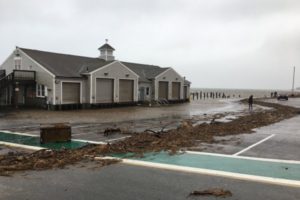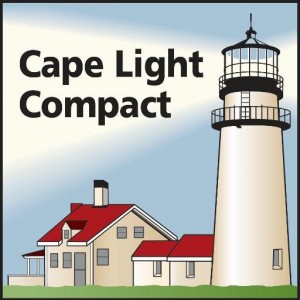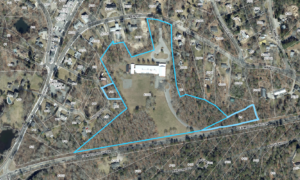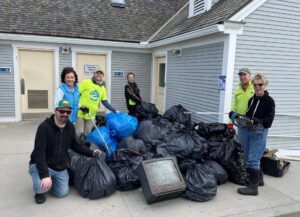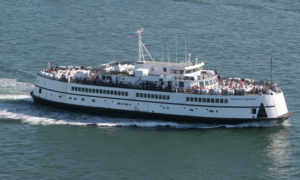Frozen water doesn’t seem like an enormously important item, but in the fishing industry it’s paramount and impacts both the bottom line and peace of mind.
Bismore Park on Hyannis Harbor has no ice machines. So, in addition to perennial problems making room for all the fishing boats that need dockage, it’s possible that a fisherman – who was on the water at 3 a.m. – might have to drive to Provincetown almost 12 hours later to get ice for the following day.
Route 6 from Hyannis to Provincetown on a summer day seems grueling, particularly when there are ice machines in Chatham. But ice there provides its own challenges; you have to lug it in totes, whereas in Provincetown a machine will just blow it in for you.
But then again, you can’t use the blowers on the Ptown ice machines after hours because they are loud and the noise bothers neighbors.
Ice. Just one factor in a litany that helps define whether a port works well, and it’s one of many often overlooked by those on the outside.
“We have all these ports up and down the coast; big ones, little ones. Our fishermen have noted discrepancies in terms of how ports manage their fishing fleets,” said Seth Rolbein, director of the Cape Cod Fisheries Trust at the Fishermen’s Alliance.
Rolbein was talking to staff at the state Division of Marine Fisheries, who had been hearing from fishermen as well. The topics were big and small: old equipment, huge variations in dockage rates between ports, commercial boats being pushed to the margins or pushed out, inadequate facilities, and other concerns.
“The DMF was thinking that they can do all this work trying to protect the fisheries, making sure there are observers and catch limits and minimum sizes and gear regulations, but if fishermen can’t land or unload economically then it is all moot,” said Rolbein.
Wanting to do something to get a sense of the challenges and strengths of various ports, the state and the Fishermen’s Alliance thought an assessment of the 70-odd ports across the state would provide a needed benchmark.
“We have definitely been approached by industry,” said Story Reed, program manager at DMF. “Those on the Cape and South Shore are talking about the need to assess, and ultimately maintain, some of the infrastructure and docking up and down the coast.”
Reed said some fishermen are concerned about losing dockage to recreational interests and having working waterfronts being repurposed as high-end homes. As the face of fisheries change, ports change too, so there may be less dragger caught fish, but more lobster boats, he added.
“Their needs might be different so we want to capture that, take a snapshot in time, and look at trends,” he said.
They reached out for help and found a willing partner in the Urban Harbors Institute at UMass Boston, which has decades of experience writing harbor plans, recently doing one for Provincetown. (Last month, Provincetown secured more than a million dollars in federal grant funding to improve its pier.)
Kristin Uiterwyk, acting director of the Institute, said her work across the state has shown all communities support commercial fishing, but how that translates on the waterfront means different things.
She added that once there is a greater understanding of each harbor’s assets and structure, there will be opportunities to develop policies and hammer out funding strategies to make improvements.
“There is so much energy around the idea of local sustainable fishing,” Uiterwyk said. “There is a lot of enthusiasm about trying to improve communities and bring them more dollars.”
With the state providing data on the type and value of species being landed at various ports, those conversations will be easier. Reed said officials and residents are often surprised about the enormous economic value the ports provide already. Investing in shoreside facilties will provide economic benefits that ripple out across communities, supporters believe.
“Improving the overall quality of the experience we have at the fish pier is almost invaluable, and not just for fishermen. I think it’s better for everyone, the town, the staff, the tourists,” said Captain Nick Muto, whose home port is Chatham.
Urban Harbors has a graduate student assigned to the project, and her first task is to see if similar plans exist in other areas of the country. The next step, said Uiterwyk, will be conducting surveys and talking to harbormasters, fishermen, and those who work at the port to describe pros and cons of the existing infrastructure – with an eye toward vulnerabilities to climate change.
Lastly, the study will look at policies already established to protect commercial fishing, what improvements might be needed, and funding opportunities and strategies. For example, some ports have a certain amount of space dedicated to commercial fishing whereas other ports leave it up to the harbormaster. Most harbormasters will give those who make their living on the sea priority, but it is important to memorialize those protections, said Reed.
There is also value in having information about how many commercial fishermen use their pier, when, and for what reasons.
“It would provide the needed information for the industry to advocate for what they need,” Reed said.
Muto works out of one of the most storied ports with a citizenry that has supported commercial fishing for generations. The fish pier is a tourist attraction with hundreds of thousands of people visiting each summer, but they walk across a parking lot filled with fishermen unloading and moving product to markets and fishermen worry about safety.
The pier itself only has space for two boats to unload at a time, which can lead to boats lined up on a busy day.
“You can wait north of two hours,” Muto said.
Muto is emblematic of commercial fishermen across the state who see how valuable the piers are, and how that value can be increased.
Rolbein said the total value of Massachusetts commercial fishery landings directly to the vessels – not including restaurant or retail sales – was $605 million in 2017. That number could well increase as ports improve their access and infrastructure.
“There hasn’t been a port study like this in decades,” said Rolbein. “Having this information compiled in one place can only help stalwart small boat fleets successfully navigate into the blue economy of the future.”
By Doreen Leggett, Community Journalist, Cape Cod Commercial Fishermen’s Alliance




